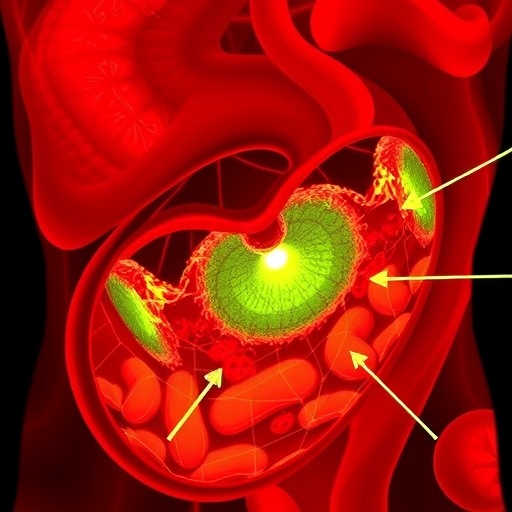
In a groundbreaking study published in Nature Metabolism, scientists at the Lewis Katz School of Medicine at Temple University have unraveled significant insights into mitochondrial calcium regulation, particularly focusing on a protein known as TMEM65. Mitochondria, often referred to as the powerhouses of the cell, are integral to energy production and cellular homeostasis. An essential component of mitochondrial function involves the transport of calcium ions, which must be meticulously balanced to avert toxic overloads that can lead to cellular dysfunction and death. The newly discovered role of TMEM65 in this intricate regulatory landscape offers a promising avenue for therapeutic innovations targeted at conditions marked by calcium dysregulation.
Calcium ions serve numerous roles within cellular physiology, acting as crucial signaling molecules that govern various processes, from muscle contraction to hormone secretion. Within mitochondria, calcium exchange is paramount for modulating energy production rates and ensuring metabolic balance. However, perturbations in calcium homeostasis can instigate pathological cascades, especially prominent in heart and neurodegenerative diseases such as Alzheimer’s. This highlights an urgent need for understanding the mechanisms that govern mitochondrial calcium dynamics, especially concerning how these processes can be manipulated for therapeutic benefit.
At the forefront of mitochondrial calcium regulation is the mitochondrial sodium-calcium exchanger (NCLX). Until now, the intricacies of NCLX regulation have remained largely uncharacterized, posing significant barriers to the development of targeted therapies for diseases characterized by mitochondrial calcium overload. Previous research linked heightened NCLX activity with favorable outcomes in heart failure and Alzheimer’s disease, yet the molecular players orchestrating its regulation were elusive. The identification of TMEM65 as a bona fide interactor of NCLX marks a significant leap forward in this domain, potentially illuminating novel strategies to enhance mitochondrial function in diseased states.
The research team, led by Dr. John W. Elrod, made a methodological innovation through biotin tagging—a technique that enabled the tracking of protein interactions within living cells. This advanced approach allowed them to pinpoint TMEM65 as a critical regulator of NCLX activity. Notably, TMEM65 emerged from the study as more than just a mitochondrial protein of unknown function; it plays a pivotal role in preventing calcium accumulation in mitochondria, thereby safeguarding against detrimental cellular implications that arise from overload.
Experiments revealed that the absence of TMEM65 leads to a significant rise in mitochondrial calcium levels, underscoring its essential function in facilitating NCLX activity. This discovery was further validated using animal models, wherein mice displaying diminished TMEM65 levels exhibited progressive loss of muscle function and mobility. These findings not only establish TMEM65’s vital role in maintaining calcium equilibrium but also strengthen the link between mitochondrial function and neuromuscular integrity.
Following these discoveries, researchers are inspired to further explore the therapeutic potential of modulating TMEM65 activity. Given the significance of calcium balance in mitochondrial functionality, enhancing TMEM65-NCLX interactions could emerge as a novel approach to treating diseases characterized by calcium dysregulation. These insights bolster the prospect of developing targeted treatments that could alter the trajectory of diseases like heart failure and neurodegeneration, providing new hope for affected individuals.
The implications of this research extend beyond mere academic curiosity; they hold profound significance for clinical outcomes. By deepening the understanding of TMEM65-NCLX interactions, the scientific community could open new avenues for drug development aimed at conditions that currently lack effective treatments. The possibility of harnessing TMEM65 as a therapeutic target raises the prospect of addressing the underlying causes of mitochondrial dysfunction, rather than merely mitigating symptoms.
As scientists continue to unravel the complexities of mitochondrial biology, the identification of key regulatory proteins like TMEM65 emphasizes the rich potential for discovery and innovation in the field of cardiovascular science. The ongoing commitment to understanding mitochondria’s role in cellular health is foundational for creating transformative therapies. Researchers at the Lewis Katz School of Medicine are indeed paving the way for a deeper understanding of cellular mechanisms and their potential therapeutic implications, which is vital in combating diseases that pose significant challenges to public health.
Overall, the study of TMEM65 and its regulation of NCLX marks a pivotal moment in mitochondrial research. As researchers delve deeper into this novel regulatory pathway, the translation of these findings into clinical applications holds the promise of revolutionizing treatment paradigms for heart failure, Alzheimer’s disease, and other calcium overload-related conditions. The intersection of basic science and clinical application exemplifies the potential for transformative breakthroughs that can impact patient outcomes positively.
This research not only generates excitement within the scientific community but also targets an urgent area in human health. The intricate balance of calcium transport in mitochondria and the factors that influence this balance can unveil strategies for mitigating cellular damage and preserving function in the face of disease. The future of mitochondrial research, fueled by discoveries such as those regarding TMEM65, will likely continue to expand our comprehension of cellular physiology and its implications for health and disease.
With continued investigation and collaboration, it is hopeful that the lessons learned from studying proteins like TMEM65 can lead to significant advancements in our understanding of cellular energetics, ultimately providing new therapeutic avenues to enhance mitochondrial resilience and combat disease.
Subject of Research: The role of TMEM65 in regulating mitochondrial calcium efflux via NCLX.
Article Title: TMEM65 regulates and is required for NCLX-dependent mitochondrial calcium efflux.
News Publication Date: 8-Apr-2025.
Web References: Nature Metabolism
References: DOI: 10.1038/s42255-025-01250-9
Image Credits: Not provided.
Keywords: TMEM65, NCLX, mitochondrial calcium, heart failure, Alzheimer’s disease, calcium regulation, mitochondrial dysfunction, therapeutic targets, cell signaling, protein interactions, drug development, cellular health.
Tags: Alzheimer’s disease researchcalcium dysregulation in diseasescalcium regulation in cellscellular homeostasis mechanismsmetabolic balance in mitochondriamitochondrial function and energy productionmitochondrial protein TMEM65mitochondrial sodium-calcium exchanger NCLXneurodegenerative disease treatmentssignaling roles of calcium ionsTemple University breakthrough studytherapeutic innovations for heart disease





